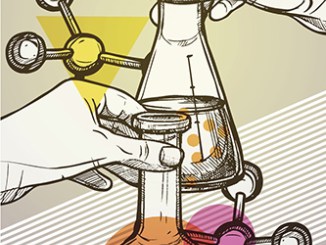
Prophylactic use of antibiotics in animal feed helps livestock stay healthy and grow faster, but it also may speed the emergence of drug-resistant bacteria that, according to the Centers for Disease Control, kill 23,000 people each year and infect up to 2 million annually.
Although Alexander Fleming's discovery of antibiotics in 1928 was a game changer in the ability to treat routine bacterial infections, the development of antibiotic resistance is a natural and inevitable phenomenon. In his acceptance speech for a 1945 Nobel Prize, Fleming noted, "It is not difficult to make microbes resistant to penicillin in the laboratory by exposing them to concentrations not sufficient to kill them."
It was only five years later in 1950 when researchers discovered putting low levels of antibiotics in the feed of healthy animals (specifically poultry) increased the speed at which they grew, resulting in higher production yields at lower costs. Under pressure to provide meat for an expanding urban population — and still feeling the stings of angry protests over high meat prices after World War I and farming struggles during World War II — meat and poultry producers quickly adopted the practice.
However, adding antibiotics to the feed of healthy animals also exposed disease-causing microbes present in these animals to non-lethal doses of antibiotics — precisely the scenario that accelerates the survival and growth of resistant bacteria. Illnesses due to resistant bacteria are more prevalent among those who work in concentrated animal feeding operations, but these "super-bugs" don't necessarily stay on the farm. Research shows they can end up in the soil, water and air surrounding meat-growing operations, where they may drift to adjacent farms, waterways or to a neighbor's backyard vegetable patch. Resistant bacteria (as well as antibiotic residue) also are present in the manure of antibiotic-fed animals, which often is used as fertilizer. And although all soil contains resistant bacteria, soil amended with manure from antibiotic-fed animals is more likely to contain bacteria resistant to multiple drugs and which require higher doses of antibiotics to kill.
In addition, resistant bacteria can be readily transported (by an infected person or simply on a farm worker's shoes or car tires) to other environments, including hospitals and clinics. Resistant strains of staphylococcus and E. coli have become medical menaces in hospitals and day care centers, putting at risk those whose natural defenses are low. Without effective treatments, health-care workers can do little but try to manage the symptoms of the sick and attempt to prevent transmission to new patients.
Part of what makes the antibiotics issue unique is that the risk of resistant bacteria affects everyone, regardless of personal dietary choices — making it not as much a food safety issue, but an environmental and public health issue. Avoiding meat from animals that were treated with antibiotics won't protect individuals from antibiotic-resistant bacteria, but that doesn't mean consumers aren't trying. In a 2012 Consumer Reports poll of American consumers, 86 percent said they agreed that local supermarkets should carry meat and poultry raised without antibiotics and more than 60 percent said they'd be willing to pay more for it.
Today, a vast majority of grocery stores now carry meat raised without antibiotics. Niman Ranch, the producer that supplies pork to the national Chipotle restaurant chain, raises its pigs without antibiotics except as needed to treat disease in individual animals. McDonald's Corporation announced its commitment to eliminate use of antibiotics important to human medicine by 2017, while the two largest chicken producers in the country, Tyson and Purdue, now offer chicken raised without antibiotics — accounting for about 9 percent of total sales.
But turning the tide, or even just holding the line, on antibiotic resistance may require more than a few boutique brands of chicken and bacon. In fact, despite an increased demand for "antibiotic-free" meat, the most recent available figures indicate sales of antibiotics to American livestock producers increased 16 percent from 2009 to 2013, including those antibiotics considered most critical to human medicine.
Raising more animals without antibiotics is a good thing, according to Patrick Baron, a fellow at the Johns Hopkins Center for a Livable Future who specializes in the epidemiology of antibiotic resistance. "But we've gone so far down this road that turning the ship around will take a much broader and more sustained effort," he says. "Subtracting a million pounds a year from a 30-million pound a year system can only do so much."
Antibiotics Reduction Legislation: Yeas and Nays
In 2007, U.S. Rep. Louise Slaughter (N.Y.) made antibiotic resistance her signature legislative issue with the Preservation of Antibiotics for Medical Treatment Act (H.R. 1150), or PAMTA. [Its respective bill in the Senate was the Preventing Antibiotic Resistance Act (S. 1256).] First introduced in 1999, the bill amended the Federal Food, Drug and Cosmetic Act to require comprehensive risk assessments and for drug manufacturers to demonstrate that there would be no harm to human health through certain uses of antimicrobials. The bill eventually garnered support from 450 medical, consumer advocacy and public health groups including the American Medical Association and the World Health Organization — as well as intense oppositional lobbying.
Anti-legislation arguments included concerns for animal health and welfare expressed by the American Veterinary Medical Association, which said PAMTA eliminated "the ability for veterinarians to prevent disease through the judicious use of antimicrobials" and pointed out that there were regulations and requirements already in place that oversee the use of antibiotics in agriculture.
Mike Apley, DVM, PhD, professor in clinical sciences at Kansas State University in Manhattan and beef production consultant, agrees. "We want drugs that are effective for humans and animals and harm neither, which is what the regulatory processes do," Apley says. "We don't want legislation that would ultimately result in circumventing regulation altogether. For example, completing qualitative risk assessments for every single drug would be physically impossible within the [PAMTA] bill's two-year timeline."
Some opponents warned that an accelerated reduction or elimination of prophylactic antibiotic use could destroy the livelihoods of meat and poultry farmers by driving down efficiency and driving up production costs — and by extension, meat and poultry prices. "Further limiting or eliminating animal antibiotic use for livestock will have negative economic and animal health consequences," according to an American Farm Bureau Federation issue brief.
Another argument is that scaling back antibiotic use in livestock is not the only means to decelerate the natural development of resistance. Up to 80 percent of the antibiotics sold today are for agricultural use; however, direct administration of antibiotics to humans also plays a role in the development of resistance. Patients demand (and physicians prescribe) antibiotics for conditions that are not caused by bacteria, such as colds, flus and unconfirmed ear or sinus infections. People may stop taking antibiotics when they begin to feel better rather than finishing the prescribed course as directed, thus eliminating the weaker bacteria but potentially allowing the stronger to survive and mutate. And pharmaceutical residues in wastewater are not always adequately removed by water treatment programs — another factor contributing to conditions that favor the emergence of drug-resistant bacteria.
About the only thing everyone does agree on that there is a significant need for committed resources to research the systemic complexities of antibiotic-resistant bacteria and the practices that create the greatest human health risk. The PAMTA bill died in committee in 2013. That year, the U.S. Food and Drug Administration issued guidelines encouraging meat producers to voluntarily phase out routine use of those antibiotics most important in human medicine.
Characterizing the FDA's guidelines as "woefully inadequate," Rep. Slaughter announced the re-introduction of PAMTA (H.R. 1552) in March 2015 [the Preventing Antibiotic Resistance Act (S. 621) was re-introduced in the Senate as a separate bill], in addition to plans to reintroduce the Delivering Antimicrobial Transparency Act, or DATA Act, which requires drug manufacturers to disclose how antimicrobials are used in food-producing animals, and large-scale poultry and livestock producers to detail the type and amount of antibiotics in their feed.
Days later, the White House released the National Action Plan for Combating Antibiotic-Resistant Bacteria, a five-year roadmap requiring "sustained, coordinated and complementary efforts of individuals and groups around the world, including public and private sector partners, health-care providers, health-care leaders, veterinarians, agriculture industry leaders, manufacturers, policymakers and patients." In addition, the U.S. Department of Agriculture's National Institute of Food and Agriculture announced more than $6.7 million in funding for research programs across the country to develop mitigation strategies for antimicrobial resistance.
"Antibiotic resistance is the most pressing public health crisis of our time," wrote Rep. Slaughter in a statement. "Both the American people and the U.S. government need to give this issue the attention it demands."







